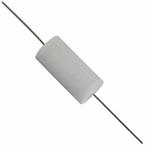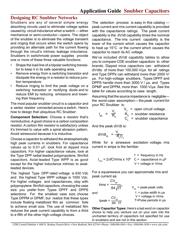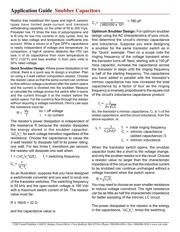herunterladen

Application Guide Snubber Capacitors
CDE Cornell Dubilier s 1605 E. Rodney French Blvd. s New Bedford, MA 02744 s Phone: (508)996-8561 s Fax: (508)996-3830 s www.cde.com
Snubbers are any of several simple energy
absorbing circuits used to eliminate voltage spikes
caused by circuit inductance when a switch — either
mechanical or semi-conductor—opens. The object
of the snubber is to eliminate the voltage transient
and ringing that occurs when the switch opens by
providing an alternate path for the current flowing
through the circuit’s intrinsic leakage inductance.
Snubbers in switchmode power supplies provide
one or more of these three valuable functions:
Shape the load line of a bipolar switching tra• nsis-
tor to keep it in its safe operating area.
Remove energy from a switching transistor and •
dissipate the energy in a resistor to reduce junc-
tion temperature.
Reduce ringing to limit the peak voltage on a •
switching transistor or rectifying diode and to
reduce EMI by reducing emissions and lower-
ing their frequency.
The most popular snubber circuit is a capacitor and
a series resistor connected across a switch. Here’s
how to design that ubiquitous RC Snubber:
Component Selection: Choose a resistor that’s
noninductive. A good choice is a carbon composition
resistor. A carbon film resistor is satisfactory unless
it’s trimmed to value with a spiral abrasion pattern.
Avoid wirewound because it is inductive.
Choose a capacitor to withstand the stratospherically
high peak currents in snubbers. For capacitance
values up to 0.01 µF, look first at dipped mica
capacitors. For higher capacitance values, look at
the Type DPP radial-leaded polypropylene, film/foil
capacitors. Axial-leaded Type WPP is as good
except for the higher inductance intrinsic to axial-
leaded devices.
The highest Type DPP rated voltage is 630 Vdc
and the highest Type WPP voltage is 1000 Vdc.
For higher voltages and capacitances, stay with
polypropylene film/foil capacitors, choosing the case
size you prefer from Types DPFF and DPPS
selections. For the smallest case size, choose
Type DPPM or DPMF, but realize that these types
include floating metallized film as common foils
to achieve small size. The use of metallized film
reduces the peak current capability to from a third
to a fifth of the other high-voltage choices.
Designing RC Snubber Networks
The selection process is easy in this catalog —
peak current and rms current capability is provided
with the capacitance ratings. The peak current
capability is the dV/dt capability times the nominal
capacitance. The rms current capability is the
lower of the current which causes the capacitor
to heat up 15°C or the current which causes the
capacitor to reach its AC voltage.
We’ve included dV/dt capability tables to allow
you to compare CDE snubber capacitors to other
brands. Dipped mica capacitors can withstand
dV/dts of more than 100,000 V/µs for all ratings
and Type DPPs can withstand more than 2000 V/
µs. For high-voltage snubbers, Types DPFF and
DPPS handle more than 3000 V / µs, and Types
DPMF and DPPM, more than 1000 V/µs. See the
table for values according to case length.
Assuming that the source impedance is negligible—
the worst case assumption— the peak current for
your RC Snubber is:
V
0
= open circuit voltage
I
pk
=
R
S
= snubber resistance
C
s
= snubber capacitance
And the peak dV/dt is:
dV/dt
pk
=
While for a sinewave excitation voltage, rms
current in amps is the familiar:
f = frequency in Hz
I
rms
= 2πfCVrms x 10
6
C = capacitance in µF
V = voltage in Vrms
For a squarewave you can approximate rms and
peak current as:
Irms =
and
Ipeak =
Other Capacitor Types: Here’s a last word on capacitor
choice to help you venture out on your own into the
uncharted territory of capacitors not specified for use
in snubbers and are not in this section.
V
0
R
S
V
pp
= peak-peak volts
t = pulse width in µs
V = voltage in Vrms
T=Pulse periods in µs
V
0
R
s
C
s
CV
pp
.64 tT
CV
pp
.64 tT






